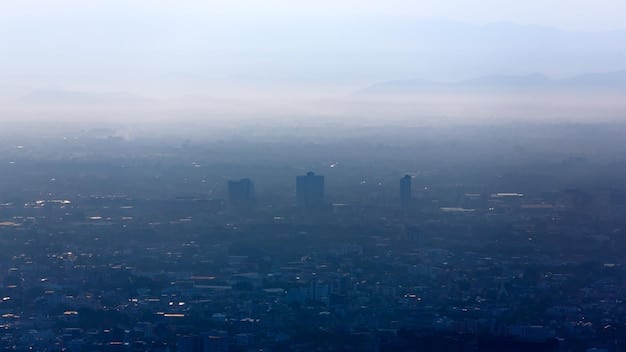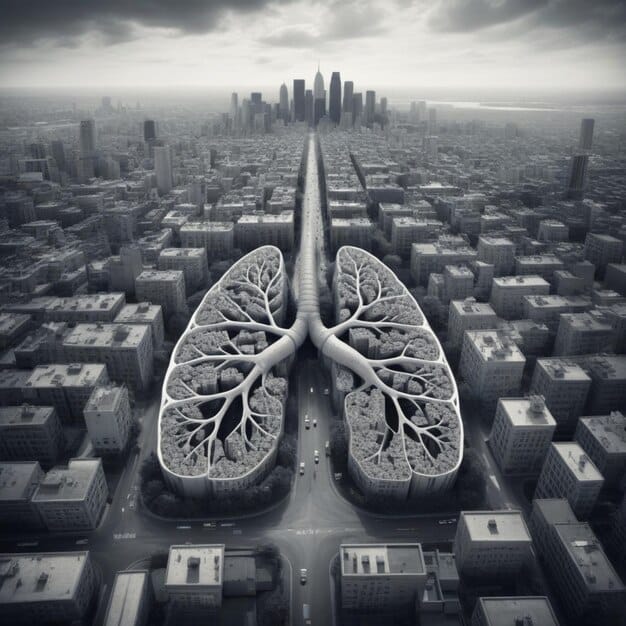Air Quality Decline: Health Risks in Major US Cities

A new study highlights declining air quality in major U.S. cities, posing significant health risks including respiratory illnesses, cardiovascular issues, and neurological damage, underscoring an urgent public health concern.
A recent study underscores a stark reality for urban dwellers: air quality in major cities is declining, revealing critical health implications for millions. This issue transcends mere environmental concern, posing direct threats to public health and reshaping our understanding of urban living.
Understanding the Air We Breathe: A Deep Dive into Urban Pollution
The air we breathe, often unseen, profoundly impacts our daily lives and long-term health. In urban centers, this invisible element is increasingly burdened by pollutants that stem from a complex interplay of industrial activities, vehicular emissions, and expanding populations. A new comprehensive study not only quantifies this deterioration but also provides a stark reminder of the intrinsic link between environmental health and human well-being. This research moves beyond mere anecdotal observations, offering data-driven insights into the pervasive issue of urban air quality.
Key Pollutants and Their Origins
Urban air pollution is not a single entity but a cocktail of harmful substances, each with unique origins and effects. Understanding these components is crucial to grasping the full scope of the problem.
- Particulate Matter (PM2.5 and PM10): These microscopic particles, often invisible to the naked eye, originate from combustion sources like vehicle exhaust, industrial processes, and power plants. PM2.5, being particularly small, can penetrate deep into the lungs and even enter the bloodstream, causing systemic issues.
- Ground-Level Ozone (O3): Unlike the beneficial ozone layer in the stratosphere, ground-level ozone is formed when pollutants from cars, power plants, and chemical factories react in the presence of sunlight. It is a major component of smog and irritates the respiratory system.
- Nitrogen Dioxide (NO2) and Sulfur Dioxide (SO2): Primarily byproducts of vehicular emissions and fossil fuel combustion, these gases contribute to respiratory problems and acid rain, further exacerbating environmental damage.
This decline in air quality isn’t just an abstract scientific finding; it manifests in tangible ways in city life. From hazy skies to increased rates of asthma attacks, the evidence is becoming harder to ignore for urban residents. Efforts to mitigate these pollutants require a multi-faceted approach, involving technological advancements, policy changes, and community engagement.
The composition of urban air is a critical environmental indicator, reflecting the cumulative impact of human activities on the planet’s atmosphere. With urbanization continuing at an unprecedented pace, the challenge of maintaining breathable air becomes even more pressing. Effective strategies must consider both immediate emission reductions and long-term sustainable urban planning.
The Unveiling of the Study: Data and Alarming Trends
Recent research, meticulously conducted and peer-reviewed, paints a troubling picture: air quality in many major U.S. cities is deteriorating at an alarming rate. This wasn’t a sudden shift but rather a culmination of subtle yet persistent negative trends, now brought to light by rigorous scientific inquiry. The study analyzed data collected over several years, utilizing advanced atmospheric monitoring techniques and incorporating insights from various environmental agencies. Its findings present a compelling case for urgent intervention.
Methodology and Key Findings
The study employed a robust methodology, combining satellite imagery, ground-level sensor data, and sophisticated atmospheric models to track pollutant concentrations. Researchers focused on a range of key air quality indicators, including particulate matter (PM2.5), nitrogen dioxide (NO2), and ground-level ozone (O3), across a representative sample of major metropolitan areas.
The findings were unequivocal:
- Increased PM2.5 concentrations: A significant uptick in fine particulate matter was observed in a majority of the surveyed cities, particularly during peak traffic hours and industrial activity periods. This indicates a worsening of one of the most dangerous forms of air pollution.
- Persistent Ozone Challenges: Despite some localized improvements, ground-level ozone levels remained stubbornly high or even increased in several urban areas, especially those experiencing hotter summers, underscoring the climate connection.
- Regional Variations but Widespread Decline: While specific cities and regions showed varying degrees of decline, the overall trend pointed towards a broad deterioration of urban air quality across the U.S., signaling a systemic rather than isolated problem.
The implications of these findings are substantial. They challenge previous assumptions about air quality improvements in certain areas and highlight the need for continuous vigilance and adaptive policy measures. The study emphasizes that current regulatory frameworks and mitigation strategies may not be sufficient to counteract the combined pressures of urbanization, industrial growth, and climatic shifts.
The data presented by this study serves as a critical benchmark, providing policymakers, public health officials, and urban planners with the evidence needed to forge more effective strategies. Without such precise measurements and objective analysis, understanding the scope of the problem and formulating targeted solutions would be far more challenging. This research is not merely an academic exercise; it is a call to action.
Immediate Health Impacts: Breathing Difficulties and Cardiovascular Strain
Declining air quality casts a wide net over public health, with some of the most immediate and tangible effects manifesting in the respiratory and cardiovascular systems. Exposure to polluted air, even for short durations, can trigger acute symptoms that range from uncomfortable to life-threatening, particularly in vulnerable populations. The pervasive nature of urban air pollution means that millions are inadvertently subjected to these health stressors on a daily basis, often without fully understanding the underlying cause of their symptoms.
Respiratory Distress: More Than Just a Cough
The respiratory system is the first line of defense against airborne pollutants, and often, the first to show signs of distress. Inhaling fine particulate matter and gaseous pollutants irritates the airways, leading to inflammation and compromised lung function.
- Asthma Exacerbations: Individuals with pre-existing conditions like asthma are highly susceptible. Increased pollutant levels can trigger severe asthma attacks, leading to shortness of breath, wheezing, and chest tightness, often requiring emergency medical attention.
- Bronchitis and Respiratory Infections: Chronic exposure can lead to acute bronchitis, characterized by persistent coughing and mucus production. It also weakens the immune system’s ability to fight off respiratory infections, making individuals more prone to colds, flu, and pneumonia.
- Reduced Lung Function: Even in healthy individuals, poor air quality can lead to a measurable reduction in lung capacity and efficiency, making physical exertion more difficult and potentially leading to long-term impairment.
Cardiovascular Burden: The Silent Killer
Beyond the lungs, the cardiovascular system is also severely impacted. Fine particulate matter (PM2.5) is small enough to enter the bloodstream, where it can wreak havoc.
When pollutants enter the bloodstream, they can cause systemic inflammation and oxidative stress, both of which are damaging to blood vessels and the heart. This can contribute to the development and progression of various cardiovascular diseases, making air pollution a significant risk factor for heart health.
The subtle yet insidious effects of chronic exposure make it difficult to attribute specific health outcomes directly to air pollution. However, the cumulative evidence from studies like the one discussed strongly suggests a pervasive and damaging influence on both respiratory and cardiovascular health, highlighting the urgent need for cleaner air in urban environments. The connection between the environment and our internal physiology is undeniable, requiring a holistic approach to public health.

Long-Term Health Consequences: Chronic Diseases and Systemic Damage
While immediate health impacts of poor air quality are concerning, the long-term consequences paint an even grimmer picture. Protracted exposure to urban pollution is increasingly linked to chronic debilitating diseases and widespread systemic damage, affecting almost every major organ system in the body. These effects accumulate over years, often manifesting much later in life, making the link less obvious but no less devastating. Understanding these long-term risks is crucial for grasping the full health burden of declining air quality.
Chronic Respiratory Conditions Beyond Asthma
Beyond acute asthma attacks, prolonged inhalation of pollutants can lead to irreversible lung damage and chronic respiratory illnesses.
- Chronic Obstructive Pulmonary Disease (COPD): Air pollution is a significant risk factor for the development and exacerbation of COPD, a progressive lung disease characterized by obstructed airflow. This includes chronic bronchitis and emphysema, leading to persistent shortness of breath and a reduced quality of life.
- Lung Cancer: Growing evidence from epidemiological studies directly links long-term exposure to particulate matter and other air pollutants with an increased risk of lung cancer, even in non-smokers. The World Health Organization classifies air pollution as a Group 1 carcinogen.
- Impaired Lung Development in Children: Children residing in highly polluted areas show slower and incomplete lung development, increasing their susceptibility to respiratory illnesses throughout their lives and potentially reducing their adult lung capacity.
Neurological and Cognitive Impairments
Emerging research highlights the insidious impact of air pollution on the brain and cognitive function. Ultrafine particles can bypass the blood-brain barrier, leading to neuroinflammation and direct damage to brain cells.
These neurotoxic effects underscore a chilling prospect: the air we breathe may be silently eroding our cognitive abilities and increasing our susceptibility to degenerative brain conditions. This area of research is rapidly expanding as scientists uncover more about the invisible connections between environmental factors and brain health. Protecting cognitive function requires a holistic view of environmental exposure.
The far-reaching health implications of chronic air pollution stress the urgency of comprehensive environmental policies. It’s not just about immediate comfort; it’s about safeguarding long-term public health and cognitive vitality. The cumulative effect of years of exposure presents a silent crisis that demands immediate and sustained action.
Vulnerable Populations: Who Is Most at Risk?
While declining air quality poses a threat to everyone, certain segments of the population bear a disproportionately higher burden of its adverse health effects. These groups are often more susceptible due to their physiological make-up, developmental stage, or pre-existing health conditions, making them particularly vulnerable to the toxic components of urban air. Understanding these vulnerabilities is critical for targeted public health interventions and for crafting equitable environmental policies. Ignoring these disparities only exacerbates existing health inequalities within communities.
Children and the Elderly: Delicate Systems
The very young and the very old represent two ends of the age spectrum that are particularly sensitive to air pollution.
- Children: Their respiratory systems are still developing, and they breathe more air per pound of body weight than adults, leading to higher exposure levels. Consequently, they are at increased risk of asthma, bronchitis, and impaired lung development. Their outdoor play habits also mean greater exposure during peak pollution times.
- The Elderly: Often with compromised immune systems and a higher prevalence of chronic medical conditions like heart disease, lung conditions, and diabetes, older adults face a heightened risk of acute exacerbations and severe outcomes from air pollution exposure. Their bodies are less resilient to environmental stressors.
Individuals with Pre-Existing Conditions
Those with underlying health issues find their conditions exacerbated by poor air quality.
Patients with cardiovascular diseases, such as coronary artery disease or heart failure, are highly vulnerable. Air pollution can trigger heart attacks, strokes, and congestive heart failure exacerbations by increasing blood pressure, promoting inflammation, and impairing heart function. This added stress can quickly push a compromised system past its breaking point.
Beyond these groups, low-income communities and communities of color often live in closer proximity to industrial sites and major transportation corridors, exposing them to consistently higher levels of pollution. This environmental injustice highlights the interwoven nature of social, economic, and environmental factors in determining health outcomes. Addressing air quality decline must therefore include a strong focus on environmental equity and justice, ensuring that burden is not disproportionately carried by those least able to shoulder it.
The Economic Toll: Healthcare Costs and Productivity Losses
The pervasive issue of declining air quality extends its reach far beyond individual health, casting a significant shadow over urban economies. The cumulative health burden translates directly into substantial economic costs, impacting healthcare systems, workforce productivity, and the overall economic vitality of affected cities. This economic toll, though often less immediately visible than health symptoms, represents a serious impediment to sustainable urban development and prosperity. Recognizing this financial dimension is crucial for motivating policy action.
Soaring Healthcare Expenditures
The direct link between air pollution and myriad health conditions inevitably leads to increased demands on healthcare services and associated costs.
Chronic diseases like asthma, COPD, and heart disease require ongoing medical management, including doctor visits, medications, and hospitalizations, all of which incur significant costs. The increase in acute episodes, such as asthma attacks or heart attacks directly attributable to pollution, places a strain on emergency services and intensive care units, further escalating expenditures. Furthermore, the long-term care for conditions like lung cancer borne from pollution adds considerable financial weight to both individuals and healthcare systems.
Diminished Workforce Productivity
A sicker population is a less productive population. Air pollution directly impacts the workforce through various mechanisms.
- Absenteeism: Illnesses triggered or exacerbated by poor air quality lead to increased sick days, significantly impacting productivity across industries. Employees suffering from respiratory issues or cardiovascular problems are simply unable to perform effectively.
- Presenteeism: Even when employees come to work, their performance can be impaired by sub-optimal health, a phenomenon known as “presenteeism.” Cognitive impacts from pollution can lead to reduced concentration, slower task completion, and increased errors, subtly eroding overall output.
- Premature Mortality: In the most tragic cases, premature deaths due to pollution-related diseases result in a profound loss of human capital and expertise, removing experienced workers from the economy entirely.
Beyond these direct impacts, adverse air quality can deter skilled workers and businesses from relocating to affected cities, thereby hindering economic growth and innovation. The perceived quality of life, heavily influenced by environmental factors, plays a role in competitive urban environments. Addressing air pollution is not just a health imperative; it is an economic necessity, an investment in sustained urban prosperity and a robust workforce. Public health and economic health are inextricably linked.

The Path Forward: Mitigation Strategies and Policy Interventions
Faced with the alarming reality of declining urban air quality, the question pivots from identification to action. Addressing this pervasive challenge requires a multi-pronged approach that integrates technological innovation, robust policy frameworks, and active community engagement. There is no single silver bullet; rather, a concerted and sustained effort across various sectors is necessary to reverse current trends and safeguard public health. The path forward demands both immediate symptomatic relief and long-term systemic change, emphasizing preventive rather than reactive measures when possible.
Technological Advancements and Infrastructure Upgrades
Innovation plays a crucial role in reducing emissions and improving air quality.
- Transition to Renewable Energy: Shifting away from fossil fuels to cleaner energy sources for power generation significantly reduces emissions of SO2, NO2, and particulate matter. Investing in solar, wind, and geothermal energy infrastructure is a cornerstone of this transition.
- Electric Vehicle Adoption: Promoting and incentivizing the widespread adoption of electric vehicles (EVs) can drastically cut tailpipe emissions in urban areas. This includes building extensive charging infrastructure and offering purchase rebates.
- Industrial Emission Controls: Implementing and enforcing stricter emission standards for industrial facilities, coupled with the deployment of advanced pollution control technologies, can curtail the release of harmful pollutants.
Policy and Regulatory Frameworks
Strong governmental policy is indispensable for driving systemic change.
Effective regulations are the backbone of any successful air quality improvement strategy. This includes setting and enforcing stringent emission limits for vehicles and industrial sources, as well as developing urban planning policies that prioritize public transport, cycling, and walking infrastructure. Such policies can reduce reliance on private vehicles and promote greener urban living, creating a ripple effect.
Furthermore, international cooperation and city-to-city learning can accelerate progress, as urban areas share best practices and collectively address transboundary air pollution. The challenge is immense, but the opportunity to create healthier, more sustainable cities is even greater. This collective will, combined with smart policy and technological ingenuity, forms the bedrock of a cleaner, more breathable future. The transformation of our urban environments into healthier spaces hinges on decisive and collaborative action.
The solutions are complex, encompassing everything from individual choices to global accords, but the urgency of the situation demands unwavering commitment and innovative thinking. Investing in cleaner air is an investment in public health, economic stability, and the overall quality of life for future generations. Ignoring the problem will only compound its costs.
| Key Point | Brief Description |
|---|---|
| 📊 Study Findings | A new study confirms declining air quality in major US cities, highlighting increased PM2.5 and persistent ozone levels. |
| ⚕️ Health Risks | Immediate impacts include respiratory and cardiovascular issues; long-term exposure linked to chronic diseases like COPD and heart disease, and neurological damage. |
| 👶 Elderly & Children at Risk | Vulnerable populations, including children and the elderly, face disproportionately higher health risks from air pollution. |
| 💡 Mitigation & Policy | Solutions involve transitioning to clean energy, promoting EVs, implementing stricter industrial controls, and robust environmental policies. |
Frequently Asked Questions About Urban Air Quality
▼
The new study indicates a significant decline in air quality across many major U.S. cities. It highlights increasing levels of fine particulate matter (PM2.5) and persistent challenges with ground-level ozone (O3), urging immediate attention to environmental health policies. The research points to widespread rather than isolated deterioration.
▼
Declining air quality carries severe health implications, including exacerbated respiratory conditions like asthma and COPD, increased risk of heart attacks and strokes, and potential neurological damage. Long-term exposure is also linked to chronic diseases and premature mortality, affecting overall public health.
▼
Children and the elderly are especially vulnerable due to developing or compromised respiratory and immune systems. Individuals with pre-existing conditions like asthma, heart disease, or diabetes also face heightened risks, as pollution can worsen their conditions or trigger acute medical events. Certain communities also bear a disproportionate burden.
▼
The economic toll from air pollution is substantial, leading to increased healthcare costs due to chronic illness and emergency treatments. It also results in significant productivity losses from absenteeism, presenteeism, and premature mortality in the workforce. This deters economic growth and strains public resources.
▼
Effective mitigation strategies include transitioning to renewable energy, promoting electric vehicles, implementing stricter industrial emission controls, and developing urban infrastructure that supports sustainable transportation. Robust policy frameworks and ongoing public education are also crucial for long-term improvement and health protection.
Conclusion
The emerging data from recent studies about declining air quality in major cities serves as a critical wake-up call. The health implications, ranging from immediate respiratory distress to chronic diseases and profound economic costs, are undeniable and far-reaching. Addressing this complex challenge demands a holistic and urgent approach, integrating technological innovation, stringent policy interventions, and a collective commitment to creating healthier urban environments. The future well-being of millions hinges on decisive action today, ensuring that our cities are not only vibrant economic hubs but also places where clean air is a fundamental right, not a luxury. By confronting this issue head-on, we can build more resilient, healthier, and sustainable communities for generations to come.





